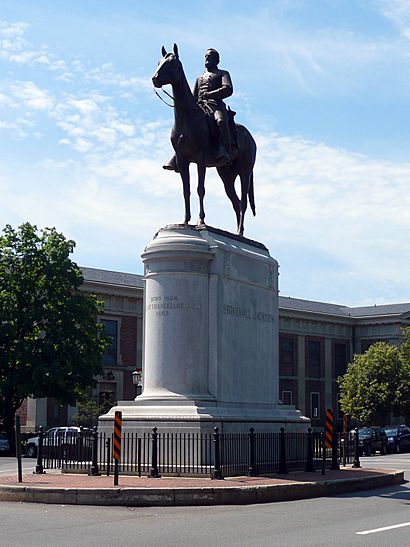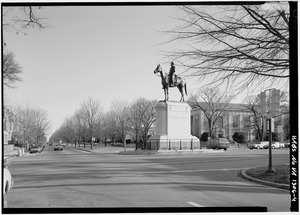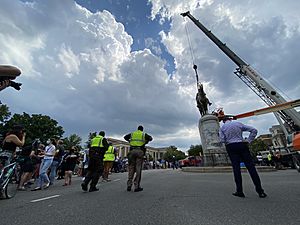Stonewall Jackson Monument facts for kids
Quick facts for kids Stonewall Jackson Monument |
|
|---|---|

Equestrian statue of Thomas 'Stonewall' Jackson in 2009
|
|
| Artist | Frederick William Sievers |
| Year | 1919 |
| Medium |
|
| Subject | Stonewall Jackson |
| Condition | Statue removed from pedestal |
| Location | Richmond, Virginia, U.S. |
The Stonewall Jackson Monument in Richmond, Virginia, was a statue built to honor Thomas Jonathon ‘Stonewall’ Jackson. He was a general for the Confederate States during the American Civil War. The monument was located where Monument Avenue and North Arthur Ashe Boulevard meet in Richmond.
This bronze statue of Jackson on his horse was revealed in 1919. It was part of an avenue that honored other famous Confederate men. These included Robert E. Lee, J. E. B. Stewart, Jefferson Davis, and Matthew Maury. Later, Arthur Ashe was also honored there.
Thomas Jackson was one of Robert E. Lee's most trusted commanders. He was important in the early part of the American Civil War. This war was fought between the Southern Confederate states and the Northern Union states. Jackson became famous after a big win for the Confederates at the First Battle of Bull Run in July 1861. He led troops until he died on May 10, 1863. He became very sick after his arm was badly wounded and had to be removed.
Many memorials were made to honor Jackson, like the statue in Richmond. Another famous one is the Confederate Memorial Carving at Stone Mountain. It honors Thomas Jackson, Robert E. Lee, and Jefferson Davis. In Southern states, generals were often honored with statues. These statues sometimes helped people feel proud of their past leaders. They also tried to make the reasons for the Confederate cause seem right.
However, many of these statues, including the Jackson monument, became very controversial. This happened after the death of George Floyd and the increased focus on the Black Lives Matter (BLM) Movement. This movement wants to show history more accurately. It also highlights the unfair treatment that Black people still face. Jackson's statue and others were either pulled down by BLM supporters or removed by the mayor's orders in June and July 2020.
Contents
Who Was Stonewall Jackson?
Jackson's life story is often shown through the statues in Southern states. These statues were meant to show his strong and steady character. From a young age, Jackson was known for being serious and determined. He joined the United States Military Academy at West Point in 1842 when he was 18. He finished 17th in his class in 1846.
After graduating, he joined the Mexican–American War as a second lieutenant. This war ended in 1848. Then, he worked as a professor at the Virginia Military Institute. He stayed there until the Civil War started in 1861. People said he was very hardworking and careful during these years. This showed in his military plans and how much he helped the Confederates early in the Civil War.
At the start of the Civil War, Jackson became known as a tough drill master. He trained new soldiers for the Confederate army. Soon after, he was asked to gather and lead a group that became known as the Stonewall Brigade. In the first major battle of the Civil War, the First Battle of Bull Run, Jackson and his brigade earned their nickname 'Stonewall'. They held their ground and defeated the Union forces, leading to a famous victory.
Jackson continued to lead forces as one of the most skilled Confederate planners. But he was wounded by friendly fire at the Battle of Chancellorsville. His arm had to be removed, and he died from pneumonia soon after, on May 10, 1863. His amazing military skills led to many stories about his role in the Confederate army. He was a big part of the ‘Lost Cause’ idea. Many statues were built in Southern states after the Civil War to remember him.
Building the Monument
Between 1890 and 1919, several statues were put up along Monument Avenue in Richmond. Local groups oversaw this project. These statues honored important Confederate men. The ‘Stonewall’ Jackson statue, like others on this avenue, was paid for by public money.
A local sculptor from Richmond, Frederick William Sievers, created both Jackson's and Mathew Maury's statues. The first stone for Jackson's monument was placed on June 3, 1915. The statue was fully revealed on October 11, 1919, shortly after World War I ended.
The official ceremony on October 11, 1919, was attended by the Governor of Richmond. Robert E. Lee's grandson spoke at the event. Thomas Jackson's granddaughter and the sculptor's son pulled ropes to uncover the finished monument. After this, there was a parade. Cadets from the Virginia Military Institute, members of the Virginia National Guard, and school children marched to the new monument. Some people thought the statue's timing was a reminder of the "brave young soldiers" returning from the war.
What the Statue Looked Like
The statue showed the Confederate general, Thomas Jackson, on his horse, Sorrel. He held the horse's reins in his left hand. The sculptor, Sievers, worked closely with war veterans. He wanted to make sure he captured the calm and spiritual feeling of the horse and rider. They looked still, focused, and steady. This was meant to show Jackson's strong and unchanging attitude. This attitude was seen from his young age, through a tough childhood, and later in his military plans and successes during the early Civil War.
The bronze statue was about 20 feet tall, 7 feet wide, and 18 feet long. Its base was made of granite and measured 20 feet tall, 9 feet wide, and 18 feet long. A wrought iron fence surrounded it. Oak leaves decorated the base of the statue. These might have been a symbol of Jackson's steady nature. There was also a Greek-style art deco design along the top of the base.
The words “STONEWALL JACKSON” were carved on the east and west sides of the granite base. On the north side, it said “BORN 1824/DIED AT CHANCELLORSVILLE/1863”. It's interesting that Jackson's statue faced north. Some people think this was meant to show him still ready to fight.
Why the Statues Were Important (and Controversial)
The statues were built along Monument Avenue between 1890 and 1919. This was when the story and support for the Confederate cause became popular again. Honoring Confederate leaders in this way was unusual. It was one of the few times in history when the losing side of a national civil war was able to celebrate their cause.
It showed that the Confederate states wanted to build memorials a generation after they failed to create their own country that allowed slavery. This was a way to try and make the Confederate experience seem right and important in American history. The Confederate cause is often called the ‘Lost Cause’. This idea tries to make the Confederate reasons for going to war seem good. It tried to say that the Confederate states were not wrong for fighting. It also tried to say they fought to keep states’ rights and control over their land and people. This included keeping slavery, which they claimed was fair and moral. The ‘Lost Cause’ story also tried to make slavery and the idea of white people being superior seem less important in why the Civil War started.
Richmond was a key place for the ‘Lost Cause’ story. Several famous Confederate men, like Lee, Jackson, and Davis, had statues along Monument Avenue. These ‘great’ Confederate commanders were often shown as brave and good. Parades and events happened every year along Monument Avenue to celebrate them. Thomas Jackson was especially important to the ‘Lost Cause’. He was one of the most important Confederate commanders until he died in 1863.
Today, these statues and monuments are widely seen as symbols of the ‘Lost Cause’ idea. Because of this, they are also seen as promoting unfair treatment based on race and old power structures in America. This is especially true in Southern states.
Why the Statues Were Removed
There were people who did not want these statues built on Monument Avenue from the very beginning. John Mitchell, a Black city councilman in the 1870s, strongly opposed honoring "blood and treason." He did not want public money used for these statues. He promised that one day, African Americans would be there to take them down.
More recently, the statues on Monument Avenue came under close review. This happened after George Floyd's death and the renewed worldwide attention on the Black Lives Matter Movement. This movement started in 2013 after the person who killed Trayvon Martin was found not guilty. The movement aims "to end the idea that white people are superior and to build local power to stop violence against Black communities by the government and others."
Through protests, the BLM movement wants to show how statues of Confederate commanders came to represent the lack of freedom and justice for Black people, both in the past and today. Richmond was a main place for celebrating the Confederate cause. So, BLM protests were very strong there. People felt it was very important to remove statues of Confederate generals, including Thomas Jackson.
These statues are now widely seen as honoring the ‘Lost Cause’. This idea slowly made the need for slavery seem normal. It also continued unfair treatment based on race. As part of the BLM protests, Jackson's monument was damaged. On July 1, 2020, the statue of him on his horse was removed by the mayor's orders. Only the base of the monument remains. Jackson's statue, along with those of James Stewart, Jefferson Davis, and Matthew Maury, were removed. The Arthur Ashe and Robert E. Lee monuments are the only ones left.
A letter to Richmond Mayor Levar Stoney and the Monument Avenue Commission showed how things are changing. This letter was from descendants of Thomas Jackson. They asked for the Jackson statue to be removed, along with all Confederate statues on the Avenue. They said these statues are clear symbols of racism and the idea that white people are superior. They recognized the need to stop honoring symbols of unfair treatment based on race. This showed a worldwide change away from honoring figures who tried to keep big inequalities in society. Issues of unfair treatment based on race are now being talked about and publicly condemned.
While the BLM movement has led to the removal of several controversial statues in America, some people believe the statues should stay. They think the statues are an important part of American history. This idea suggests that these monuments should not be seen as making unfair treatment based on race seem good. Instead, they should serve as a strong reminder of racism, slavery, and unfair power structures. These are issues that America and the rest of the world have faced historically and still face today.
American Historian James M McPherson suggests that removing these Confederate statues erases important parts of American history. He recommends that signs explaining who put them up, when, why, and for what reason would be a better solution. In this way, some believe that keeping these statues would make sure American history is told completely. Important details, like the unfair treatment many people of color experienced, would not be left out or hidden, as they were when the 'Lost Cause' story was supported.
Images for kids






